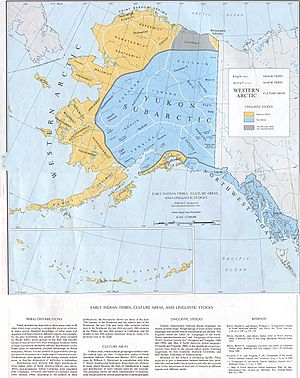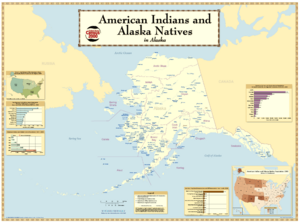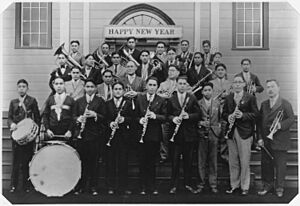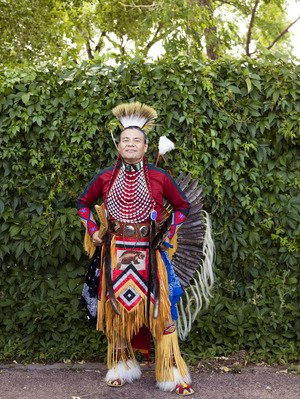Alaska Natives facts for kids
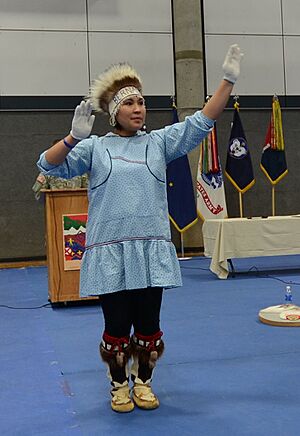
Alaskan Yup'ik Native dancer performing in Fairbanks (2013)
|
|
| Total population | |
|---|---|
| ≈106,660 (2006) | |
| Regions with significant populations | |
| Languages | |
| English, Alaskan Russian, Haida, Tsimshianic languages, Eskaleut languages (Inupiaq, Central Alaskan Yup'ik, Alutiiq, Aleut), Chinook Jargon, Na-Dené languages (Northern Athabaskan, Eyak, Tlingit), others | |
| Religion | |
| Traditional beliefs (some still practiced) Alaska Native religion, Christianity (Protestantism, Eastern Orthodoxy, Roman Catholicism) |
|
| Related ethnic groups | |
| Alaskan Creoles, Native Americans, First Nations, Inuit |
Alaska Natives are the original people who have lived in Alaska for thousands of years. They are also called Native Alaskans or Indigenous Alaskans. These groups include many different cultures and languages. Some well-known groups are the Iñupiat, Yupik, Aleut, Eyak, Tlingit, Haida, Tsimshian, and various Northern Athabaskan peoples.
Many Alaska Native groups are officially recognized by the government. They are part of 13 Alaska Native Regional Corporations. These corporations help manage land and money for the Native communities.
The ancestors of Alaska Natives came to Alaska thousands of years ago. They likely traveled from Asia, possibly over a land bridge called Beringia or by sea. These early people developed amazing ways to live in Alaska's cold and challenging environments.
Their languages have always been a very important part of their identity. Today, more than 20% of Alaska's population are Alaska Natives.
Contents
Alaska Native Peoples and Their Languages
Alaska Natives are often grouped by their historical languages. Each group can also have many different tribes within it. Here is a list of some of the different Alaska Native peoples:
- Ancient Beringian
- Alaskan Athabaskans
- Ahtna
- Deg Hit'an
- Dena'ina
- Eskimo
- Eyak
- Gwich'in
- Haida
- Hän
- Holikachuk
- Koyukon
- Lower Tanana
- Tanacross
- Upper Tanana
- Upper Kuskokwim (Kolchan)
- Tlingit
- Tsimshian
- Iñupiat, an Inuit group
- Yupik
- Siberian Yupik
- Yup'ik
- Cup'ik
- Nunivak Cup'ig
- Sugpiaq ~ Alutiiq
- Chugach Sugpiaq
- Koniag Alutiiq
- Aleut (Unangan)
Alaska Native Population Today
In 2018, Alaska Natives made up about 15.4% of all people living in Alaska. In 2013, a study found over 120,000 Alaska Native individuals living in the state.
Many Alaska Native people live in smaller villages or regional towns like Nome, Dillingham, and Bethel. However, more and more Native Alaskans are moving to bigger cities. In 2010, about 44% lived in urban areas, which was an increase from 38% in 2000.
History of Alaska Natives
The modern history of Alaska Natives began in the 1700s. This is when they first met Russian explorers who came from Siberia. Later, in the 1800s, British and American traders arrived from other parts of North America.
Russian Colonial Period in Alaska
In the 18th century, Vitus Bering saw Alaska during an expedition. Soon after, Alaska Natives began to meet Russians. The timing of these meetings varied across different Native groups.
Russians arrived by ship in the mid-1700s and started trading with Alaska Natives. They built settlements around their trading posts, especially in the Aleutian Islands. Russian Orthodox missionaries also came and were the first to translate Christian writings into Native languages like Tlingit. Even today, many Russian Orthodox Christian churches in Alaska have mostly Alaska Native members.
Russian traders encouraged the Aleut people to hunt for valuable furs. As the fur trade grew, competition between Russian companies increased. This led to difficulties between the traders and Native people. Life became very hard for the Aleut people and other Native Alaskans.
When some Aleut people resisted, the Russians responded with force. They damaged hunting tools and boats, which made it hard for the Aleuts to survive. Sadly, new diseases brought by the Russians caused many Aleut people to become very sick. Their bodies were not used to these illnesses, and a large number of people passed away.
Changes from Russian Influence
The Russian government expanded into Alaska for its own reasons. They used the natural resources of the land, and the Russian Orthodoxy faith spread. Their arrival changed the lives and lands of the Native communities.
Historians suggest that the Russian-American Company used Native people for work without fair pay. The company not only used Native populations for labor but sometimes held family members until furs were provided as a tax. This was a method the Russians had used before in Siberia.
The Russian-American Company sometimes used military force on Native families. They would hold family members until male community members provided furs. They also treated Native people harshly and sometimes withheld food. In 1799, a tax paid in furs was stopped. However, the government then required Native men aged 18 to 50 to hunt seals for the Russian-American Company.
This mandatory work gave the company an advantage over American and British traders. But it also meant men were away from their homes, which changed family life and communities. With men away, villages had less protection, leaving women, children, and the elderly behind.
In addition to these changes, the spread of disease greatly affected Native communities. Records from that time are scarce, but it is believed that a large part of the Aleut population was gone by 1800. The Alaska Native population continued to decline until 1910. It was not until 1947 that the population numbers grew past the 1880 figures.
Over time, some Native women and Russian traders married and had children. These children became known as Creole peoples, having both Native and Russian heritage. To improve relations with Aleutian communities, traders were encouraged to marry Native women. The Creole population grew in areas controlled by the Russian-American Company.
The growth of the Russian Orthodox Church was another important part of this period. Ioann Veniaminov, who later became Saint Innocent of Alaska, was a key missionary. The church encouraged Creole children to follow Russian Orthodox Christianity. The Russian-American Company also provided them with an education. Many Orthodox missionaries, like Herman of Alaska, helped protect Native people from unfair treatment.
American Colonial Period in Alaska
Alaska had many natural resources, especially gold, which interested the United States. In 1867, the United States bought Alaska from Russia. This purchase happened without asking the opinions of Native Alaskans, who were not considered citizens at the time. Their traditional lands were often taken by new settlers without payment or recognition.
The only schools available for Alaska Natives were those set up by religious missionaries. Many new settlers did not respect the rich cultures of Native Alaskans and treated them unfairly.
The Klondike Gold Rush of 1896–1898 brought more settlers to Alaska. New American settlers brought unfair rules and treated Native Alaskans differently. They faced segregation, meaning they were kept separate from others in public places, and had fewer opportunities. Signs like "whites only" were common, preventing Native people from entering certain buildings.
Native children also faced challenges in schools. Sometimes they could only attend if their families gave up their traditional ways. The U.S. government also had policies that aimed to change Native Alaskan cultures. Children were often sent to special boarding schools, far from their homes. In these schools, they were not allowed to speak their native languages, wear traditional clothes, or practice their customs. This caused many families to be separated and led to a loss of cultural traditions.
In 1912, the Alaska Native Brotherhood (ANB) was formed to fight for citizenship rights. The Alaska Native Sisterhood (ANS) was created in 1915. That same year, a law was passed allowing Native Alaskans to vote, but only if they gave up their cultural customs. The Indian Citizenship Act of 1924 finally gave all Native Americans United States citizenship.
The ANB became very influential in the 1920s. They protested the segregation of Alaska Natives in public places and organized boycotts. Alberta Schenck (Inupiaq) famously protested segregation in a movie theater in 1944. With the help of Elizabeth Peratrovich (Tlingit), the Alaska Equal Rights Act of 1945 was passed, ending segregation in Alaska.
During World War II in 1942, many Aleut people were moved from their homes in the Aleutian Islands for safety. However, this move was not handled well, and many became sick or passed away, especially the elderly and children. When survivors returned, they found their homes and belongings damaged or gone.
The Alaska Equal Rights Act of 1945 was the first anti-discrimination law in the U.S. It ensured all Alaskans had "full and equal enjoyment" of public places and businesses. This law made discriminatory actions punishable by fines or jail time.
Alaska officially became the 49th state of the United States in 1959.
ANCSA and Modern Times (1971 to Present)
In 1971, with the support of Alaska Native leaders like Emil Notti, Willie Hensley, and Byron Mallott, the U.S. Congress passed the Alaska Native Claims Settlement Act (ANCSA). This act settled land and financial claims for lands and resources that Alaska Natives had lost. It also created thirteen Alaska Native Regional Corporations to manage these claims.
Alaska Natives have a unique relationship with the U.S. government. Their interactions happened in a different historical period than those of other Native Americans in the United States. Their land rights were handled differently than other Native American groups.
The Allotment Act was ended in 1971, and reservations were also ended. Unlike most other Native American tribal governments, Alaska Native tribal governments do not collect taxes on businesses on their lands. However, under the Marine Mammal Protection Act of 1972, Alaska Natives have the right to hunt whales and other marine mammals.
Climate Change Impacts on Alaska Natives
Four Native tribes in Alaska—the Shishmaref, Kivalina, Shaktoolik, and Newtok tribes—are considered America's first climate refugees. This means they have to move because of changes in the environment. Melting sea ice and more wildfires are causing big problems for them.
Climate change creates many challenges for Alaska's Native peoples. These include health issues, injuries, and problems getting enough food and water. The Environmental Protection Agency (EPA) says that coastal erosion from melting sea ice is forcing Native communities to move. This melting also changes where animals go, which tribes depend on for food. It also destroys traditional places to store harvested food. As the ground called permafrost thaws, buildings become unstable, causing villages to collapse.
The Shishmaref, Kivalina, Shaktoolik, and Newtok tribes live on Alaska's west coast. Here, rising sea levels have made storms worse, eroding their coastlines. These communities face forced migration because there is no suitable nearby land to relocate to. This means they might have to leave their traditional ways of life. Experts predict that a major climate event could completely cover these tribal lands in less than fifteen years.
The changing climate has also made things more dangerous for Alaska Natives. In the past, thick ice was present year-round. Now, warmer temperatures have made the ice thinner, leading to more people falling through. This can cause serious health problems. Water shortages and damaged buildings have created sanitation issues, leading to more respiratory illnesses across Alaska. In 2005, pneumonia became a leading cause of hospital stays in these regions.
Many affected communities feel a lot of stress because of climate change. They worry about moving and the damage to their homes from thawing permafrost. Food security has also gotten worse as animals move to new habitats. Traditional underground ice cellars, which used to stay frozen all year, now thaw in the summer. This makes stored food unsafe to eat.
Subsistence Living
Gathering food from the land and sea is still a very important part of life for many Alaska Natives. This is called subsistence living. In Utqiaġvik, Alaska, in 2005, more than 91% of Iñupiat households still participated in hunting, fishing, or gathering for food. This was compared to about 33% of non-Iñupiat households.
Unlike some other Native American groups, Alaska Natives do not have treaties that fully protect their rights to hunt and fish for food, except for marine mammals. The Alaska Native Claims Settlement Act changed their traditional hunting and fishing rights in Alaska.
See also
 In Spanish: Nativos de Alaska para niños
In Spanish: Nativos de Alaska para niños
- List of Alaska Native Tribal Entities, the list of Native Villages and other "tribal entities" recognized by the US Bureau of Indian Affairs.
- Prehistory of Alaska
- First Alaskans Institute
- Indigenous Amerindian genetics
- Circumpolar peoples
- Indigenous peoples of the Pacific Northwest Coast
- Indigenous peoples of the Subarctic
- Alaska Native Language Center



